Solana’s native token SOL (SOL) rose 7% on January 22 despite failing to recover the $260 support level. More importantly, SOL is up 34% so far in 2025, while the broader altcoin market is up 10%. This rise has been largely fueled by Memecoin trading hype, especially following the launch of the official TRUMP token on January 18th.
If SOL rises above $280, it could face a hurdle.
It may take longer than expected for SOL to rise above $280, as several on-chain and derivatives indicators have declined from recent highs. This trend won’t stop SOL from challenging the all-time high of $295 it reached on January 19, but it does raise concerns about the durability of recent inflows. For example, Solana network fees decreased 67% to $11.7 million on January 21 compared to January 19.
Solana Network Daily Transaction Fee (USD) Source: DefiLlama
The decline in Solana fees coincides with a decline in trading activity for Raydium, Pump.fun and Orca, although overall levels are higher than last week. At the same time, fees remain unchanged for other decentralized applications (DApps) such as Jito, Meteora, Photon, and Moonshot.money.
Investors should note that while memecoins are not the only use case for Solana, the network activity driving recent demand appears unsustainable.
Solana Network daily active addresses. Source: Glassnode
A similar pattern was seen in daily active addresses, which peaked at 16.5 million on January 20 and then declined to 13 million, according to Glassnode data. However, it would be naive to evaluate Solana’s network activity without comparing its competitors’ data.
Traders move into stocks amid optimism about President Trump’s election
Traders may have turned to the stock market following Donald Trump’s recent election victory, fueled by optimism about corporate tax cuts, import tariffs and a business-friendly environment.
The S&P 500 index rose 0.8% to an intraday high of 6,100 on January 22, thanks in part to Netflix, which rose 11% after surpassing 300 million paying subscribers. Additionally, Oracle shares rose 7% and Nvidia rose 4% on news of OpenAI, a joint venture with Oracle and SoftBank that includes plans to invest at least $500 billion. Keith Lerner, Truist’s co-chief investment officer, told CNBC:
“Today is another reminder that the dominant theme of this bull market is artificial intelligence and technology.”
Despite the overall slowdown in on-chain activity, Solana’s decentralized exchange (DEX) market share remains strong, holding the number one spot for the past seven days.
DEX daily trading volume (USD) by network Source: DefiLlama
On January 21, Solana recorded DEX trading volume of $11.9 billion, and the BNB chain and Ethereum combined recorded $7.4 billion. Solana’s dominance has remained above 45% since January 16, compared to the previous week’s average of 34%. In essence, Solana’s slowdown in on-chain activity simply reflects traders’ focus shifting to the stock market.
relevant: U.S. Congressman: Trump Coin could threaten national security
Investors should investigate leverage demand in the SOL futures market. When bullish sentiment prevails, perpetual contract (inverse swap) funding rates typically rise above 1.9% per month. This means that long (buy) positions pay leverage costs.
SOL perpetual futures 8-hour funding rate. Source: Coinglass
Over the past two days, demand for SOL leverage has been balanced between bullish and bearish, with the current indicator sitting at 0.5% per month. In particular, on January 20th, traders showed increased demand for short-term (sell) leverage.
Unless a new catalyst emerges for SOL, such as the approval of the spot Solana exchange-traded fund (ETF) in the U.S., chances of regaining the all-time high of $295 any time soon appear limited.
This article is written for general information purposes and should not be considered legal or investment advice. The views, thoughts and opinions expressed herein are those of the author alone and do not necessarily reflect or represent the views and opinions of Cointelegraph.

